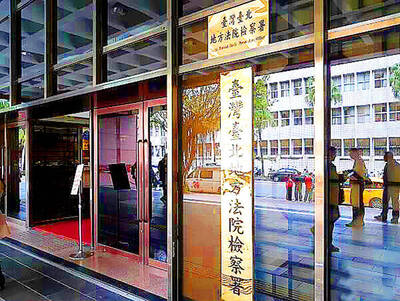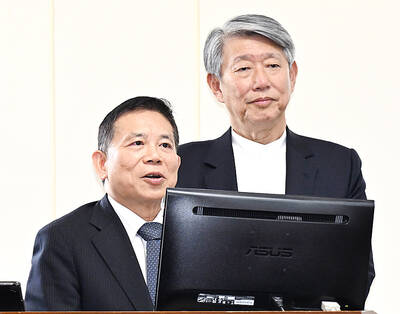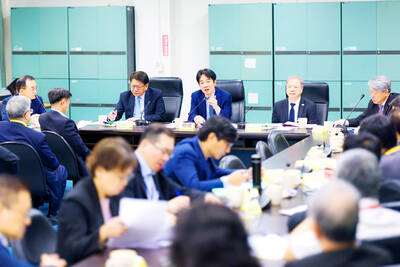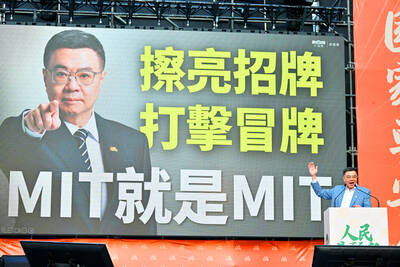For the first time in three years, senior officials at the US Department of State and the Pentagon are talking seriously about arms sales to Taiwan, US-Taiwan Business Council president Rupert Hammond-Chambers said on Sunday.
“I am optimistic because I am seeing activity,” he said at a press event to launch the 13th annual US-Taiwan Defense Industry Conference.
Held in Williamsburg, Virginia, this year, the conference is a major forum for high-level arms sales discussions and its sessions are closed to the press.
Hammond-Chambers and other attendees said they feel it is significant that the US government has sent a heavyweight team to the summit, one which includes the No. 2 official at the State Department’s political-military office, Todd Chapman. Chapman is the most senior State Department official to attend the event for more than a decade.
“We are very happy that he is here, his willingness to come is truly important,” Hammond-Chambers said.
Taiwan’s delegation is led by Deputy Minister for National Defense General Chiu Kuo-cheng (邱國正) and Director-General for the Armaments Bureau Lieutenant-General Chin Shou-fong (金壽豐). Chiu is the Ministry of National Defense’s pointman for arms sales.
The pair are accompanied by several other senior officers, including those responsible for Taiwan’s submarine program.
Washington has also sent “significant representatives” from the State Department and the US Department of Defense, among which are American Institute in Taiwan (AIT) Chairman Ray Burghardt and the managing director of the AIT’s Washington office, Joe Donovan.
“It’s tremendous that both sides have sent such really strong groups,” Hammond-Chambers said. “We have an excellent turnout.”
With total attendance at about 135, Hammond-Chambers said he is pleased about what high-ranking delegates’ presence “might mean over the next couple of years in respect to the US engaging Taiwan on security matters.”
Still, he expressed concern that it has been three years since the F-16 upgrade program was agreed, adding that this period is the longest since 1979 that the US has gone without selling arms to Taiwan.
The two-day conference is to feature wide-ranging panel discussions and speeches on Taiwan’s security. It ends today with what could be the most important session of all: one regarding the nation’s indigenous submarine program.
Hammond-Chambers said that there was “growing momentum” behind the submarine initiative, adding that President Ma Ying-jeou (馬英九) was fully committed and there was talk — both public and private — that funding would be available to pay for the right plan.
He said that a US Congressional Notification prepared in 2008 for a Taiwanese submarine program was still awaiting action at the State Department.
Hammond-Chambers predicted that there is likely to be some kind of arms sale to Taiwan before US President Barack Obama’s administration’s tenure ends in 2016, but warned that there was increasing resistance within the White House to providing new equipment.
The direction of the US’ support for arming Taiwan is moving toward upgrading equipment or supplying components and subsystems for domestically produced weapons, he added.
“That’s different from what we have been prepared to do in the past,” Hammond-Chambers said.
The US last sold a new weapons system to Taiwan in 2006.
Asked whether the next sale would include a new weapons system, he said: “Recent history suggests not.”
The council president said that the US arguably has the best submarine technology in the world and could support a program in Taiwan by selling subsystems and munitions.
However, he added that the council would prefer the release of a Congressional Notification authorizing a US$360 million plan to design submarines for Taiwan — probably in the 1,500-tonne to 2,000-tonne displacement range.
If that happened, Hammond-Chambers said it was likely that a European nation would offer the design of the submersible.
He also forecast that there would be “noise” from the US Congress in the next two weeks supporting the sale of new F-16C/D aircraft to Taiwan.
“Congress is going to start getting involved again in the arms sales issue,” he said.
The nation’s existing F-16s will start to be upgraded in 2016 and as they go out of service, a “fighter gap” will open up.
“There is a requirement for these fighters and they are going to have to come from somewhere. Taiwan needs new fighters now. They need to be ordered as soon as possible for delivery in time to cover the Taiwan fighter gap,” Hammond-Chambers said.
He said that the government’s priority seems to be submarines, but the military continues to push for submarines and fighters.
Hammond-Chambers said that from Washington’s point of view, there was probably “more wiggle room” to sell submarines because a domestic building program in Taiwan would fit better with the Obama administration’s “no new platforms” strategy.
“Some may calculate it [the strategy] reduces the issue with the Chinese, although I don’t think so,” Hammond-Chambers said, adding that his “wish list” for Taiwan over the next three years included submarines, fighter planes and a place in the developing Trans-Pacific Partnership trade bloc.
“These are the big things we want to see happen. You have to think big. They are important and difficult, but they are doable and they are reachable goals,” he said.

INVESTIGATION: The case is the latest instance of a DPP figure being implicated in an espionage network accused of allegedly leaking information to Chinese intelligence Democratic Progressive Party (DPP) member Ho Jen-chieh (何仁傑) was detained and held incommunicado yesterday on suspicion of spying for China during his tenure as assistant to then-minister of foreign affairs Joseph Wu (吳釗燮). The Taipei District Prosecutors’ Office said Ho was implicated during its investigation into alleged spying activities by former Presidential Office consultant Wu Shang-yu (吳尚雨). Prosecutors said there is reason to believe Ho breached the National Security Act (國家安全法) by leaking classified Ministry of Foreign Affairs information to Chinese intelligence. Following interrogation, prosecutors petitioned the Taipei District Court to detain Ho, citing concerns over potential collusion or tampering of evidence. The

NEGOTIATIONS: Taiwan has good relations with Washington and the outlook for the negotiations looks promising, Minister of Economic Affairs J.W. Kuo said Taiwan’s GDP growth this year is expected to decrease by 0.43 to 1.61 percentage points due to the effects of US tariffs, National Development Council (NDC) Minister Paul Liu (劉鏡清) said at a meeting of the legislature’s Economics Committee in Taipei yesterday, citing a preliminary estimate by a private research institution. Taiwan’s economy would be significantly affected by the 32 percent “reciprocal” tariffs slapped by the US, which took effect yesterday, Liu said, adding that GDP growth could fall below 3 percent and potentially even dip below 2 percent to 1.53 percent this year. The council has commissioned another institution

NEGOTIATIONS: The US response to the countermeasures and plans Taiwan presented has been positive, including boosting procurement and investment, the president said Taiwan is included in the first group for trade negotiations with the US, President William Lai (賴清德) said yesterday, as he seeks to shield Taiwanese exporters from a 32 percent tariff. In Washington, US Trade Representative Jamieson Greer said in an interview on Fox News on Thursday that he would speak to his Taiwanese and Israeli counterparts yesterday about tariffs after holding a long discussion with the Vietnamese earlier. US President Donald Trump on Wednesday postponed punishing levies on multiple trade partners, including Taiwan, for three months after trillions of US dollars were wiped off global markets. He has maintained a 10 percent

TRADE: The premier pledged safeguards on ‘Made in Taiwan’ labeling, anti-dumping measures and stricter export controls to strengthen its position in trade talks Products labeled “made in Taiwan” must be genuinely made in Taiwan, Premier Cho Jung-tai (卓榮泰) said yesterday, vowing to enforce strict safeguards against “origin laundering” and initiate anti-dumping investigations to prevent China dumping its products in Taiwan. Cho made the remarks in a discussion session with representatives from industries in Kaohsiung. In response to the US government’s recent announcement of “reciprocal” tariffs on its trading partners, President William Lai (賴清德) and Cho last week began a series of consultations with industry leaders nationwide to gather feedback and address concerns. Taiwanese and US officials held a videoconference on Friday evening to discuss the